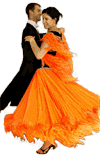 |
ROUND DANCING — CHOREOGRAPHED BALLROOMEDUCATIONAL ARTICLESMAJOR SECTIONS: Figures | Articles | Links | Alph. Index | Search | Home |
|
|
Dance In Response To Your Partnerby Harold & Meredith Sears We recently read that good communication is made up of —
Ladies, you carry the most obvious part of this burden, given traditional lead and follow. Don't hear the cue and then dance the figure. Don't anticipate the lead. If you do, you are leading, and you will feel a tussle, like four hands on a steering wheel. Responding to your partner is both visual and tactile. Your eyes may be up and left, but you can learn to keep your partner in your peripheral vision and to pay attention to his head and shoulder movements. Properly, these movements will be an integral part of his frame movements, and you will feel them through your toned frame, but the more sensory input, the better. You hear the cue, so you are prepared for what will happen. Then you see and feel the lead. Think of it as triple input. You can follow with extra confidence. You might think that it would be useful to watch your partner's feet. There is no more direct signal of where he is going to step, and at a very simple level, it is true that if you can see him step through to a New Yorker, then you can do it too. But there are unfortunate consequences:
Maintain your frame, ladies. Maybe the first thing to think about here is simply supporting your own arms. Rotate your shoulders back, and lift just a little through your shoulders, back, arms, wrists, and even fingers. Don't raise your arms above your shoulders, and, men, if you are taller, lower your arms a bit to accommodate. This attention to the arms does two things. First, it simply gets the woman's weight off her partner. Second, it puts the tone in her upper body that will allow her to feel and respond to his movements. In round dancing, of course we pay attention to the cues, but our dancing becomes smooth only when we pay equal attention to — when we watch, feel, and respond to — our partner.
Published
in the Washington Area Square Dancers Cooperative Association (WASCA) Calls
'n' Cues, 50-2:9, 10/2009;
reprinted Texas Round Dance Teachers
Association (TRDTA) Newsletter, October 2011.
If you would like to read other articles on dance position, technique, styling, and specific dance rhythms, you may visit the article TOC. Past DRDC Educational Articles archived here. Go beyond this site. Find other references on our Sources and Links pages.
|
 |
|
|